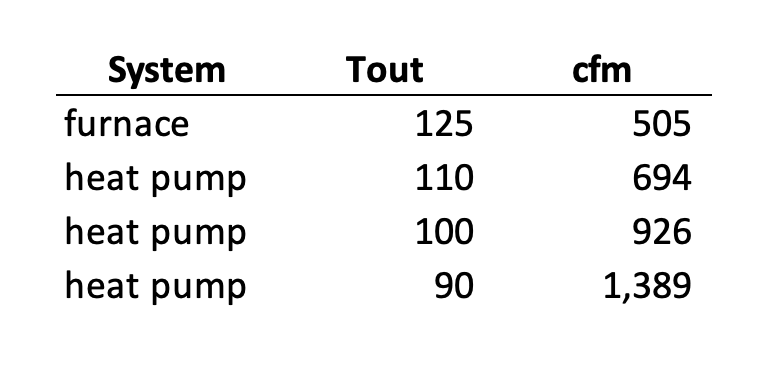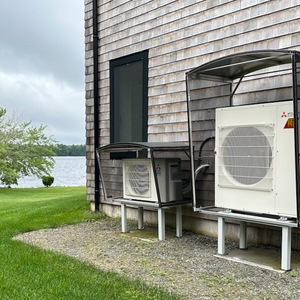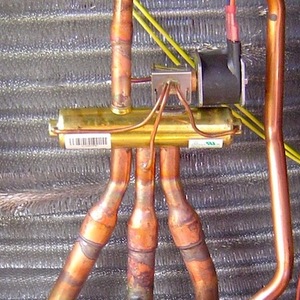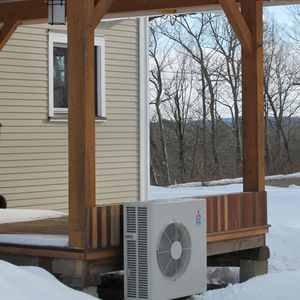
Oh, the dreaded “cold blow.” That’s HVAC technician-speak for a forced-air heating system that blows cold air on the occupants of a home. Is it really a problem? Is the supply air from a heat pump really cold? How many homeowners experience this problem? And is the problem really due to using a heat pump instead of a furnace?
Supply air temperature
How warm is the air after being heated by furnaces and heat pumps? Furnaces do make hotter air than heat pumps, so let’s look at some typical temperatures for each type of heating system.
Furnace – If the furnace is installed properly (more on that below), the air coming off the heat exchanger should be somewhere around 150 °F (66 °C). It might be warmer. It might be cooler. Most of the time, though, it cools off some by the time it comes out of the vents. Let’s say it comes out at 125 °F (52 °C).
Heat pump – Again, assuming proper installation, the supply air coming off the coil of a heat pump will usually be between 90 °F (32 °C) and 110 °F (42 °C). The photo above shows that the temperature of the air coming out of my heat pump was 105 °F (40 °C) when I took the reading.
So, yeah, a furnace makes hotter air than a heat pump. Does that make it better? Hmm. Let’s explore that idea.
Is the air warm enough?
The recommended indoor design temperature for winter is 70 °F (21 °C). Can a heat pump’s 90 °F air coming out of the vents warm the indoor air to 70 °F? Of course it can. Can it heat that air as much as 125 °F furnace air? Of course it can.
The key to heating a house sufficiently with cooler air is to increase the airflow rate. It’s about the amount of heat being transferred, not just the temperature. Using the old-fashioned American units, the rate of heat transfer depends two main factors: the airflow rate and temperature difference (ΔT). Here’s the equation we use to do calculations for this:

Don’t worry. I’m not going to do any more with it except tell you that’s how I got the following airflow rates for heat pumps and furnaces. If you want more details about this equation, see my article on airflow and heat transfer.
Let’s say the heating load on your house is 30,000 BTU/hr, and you keep the indoor air temperature at 70 °F. Those numbers are fixed for our example. The input numbers that change are the supply air temperature of the heat pump and furnace. From those, we can calculate how much air we need to move to keep the house at the desired temperature.

So there’s no problem keeping the house warm enough with lower temperature air. You just have to move more air because each cubic foot of air has fewer BTUs in it.
A cardinal rule of duct design
When I hear of someone complaining about cold air blowing on them from their heating system, my first thought is about duct design. One of the most important rules of duct design is: Don’t blow air on people!
The air coming out of the vents is warmer than room air in winter and cooler in summer. That can lead to comfort complaints any time of year. The way to prevent those complaints is to follow the rule above during the design process. Failing that, changing the type of supply vent or maybe adjusting the louvers can help mitigate the problem after the fact.
By not blowing air directly on people, the conditioned air has a chance to mix with the rest of the air and come to the proper temperature by the time occupants feel it.
What else can make the heated air cooler?
It seems, though, that heat pumps get more blame for “cold blow” than furnaces do. Yes, they send lower temperature air into the house, but as I said above, proper design should eliminate that as an issue.
But there is another reason people might complain about heat pumps blowing cold air, too. Heat pumps go into a defrost cycle occasionally to keep ice from building up on the outdoor unit. During defrost, the system isn’t heating and may blow cooler air into the house. Some systems use auxiliary heat to warm up that air during defrost, but not all heat pumps have auxiliary heat.
Cold blow can happen with furnaces, too
Then there are a few reasons for “cold blow” that apply to both heat pumps and furnaces. One is duct leakage. If the return side of the duct system pulls in enough cold air from unconditioned spaces (attic, crawlspace, garage, etc.), the entering air temperature drops. That results in a lower output temperature for the heating system.
A second cause could be poorly insulated ducts in unconditioned space. The return air gets colder on its way to the heating system and the supply air gets colder after being heated.
A third cause is mixing outdoor air for ventilation into the system. When it’s really cold outdoors, this can decrease the supply air temperature of both heat pumps and furnaces.
And a fourth cause here could be setting the thermostat to keep the blower running all the time, even when the system isn’t heating the air that passes through it.
Don’t blame the heat pump
My 1961 house gets nice and warm with my heat pump that produces 105 °F air. I took that photo on a chilly evening when the outdoor air temperature was 32 °F. At the same time, our ductless unit in the sunroom was cranking out 98 °F air. And the house felt nice and toasty because we were getting plenty of BTUs.
Yes, the supply air from a heat pump is cooler than that from a furnace. Yes, the heat pump stops heating during the defrost cycle. But those aren’t a problem if the system doesn’t blow air on people. As long as the heat pump is sized properly and has auxiliary heat if necessary, it shouldn’t be the cause of comfort problems.
____________________________________________________________________
Allison A. Bailes III, PhD is a speaker, writer, building science consultant, and the founder of Energy Vanguard in Decatur, Georgia. He has a doctorate in physics and is the author of a bestselling book on building science. He also writes the Energy Vanguard Blog. For more updates, you can subscribe to Energy Vanguard’s weekly newsletter and follow him on LinkedIn. Images courtesy of author.
Weekly Newsletter
Get building science and energy efficiency advice, plus special offers, in your inbox.















2 Comments
If you are considering a heat pump and are worried about this, stop worrying.
My ducted mini split heat pump blows air warm enough to make standing over the registers very pleasant when you come in from the cold in the winter. And it absolutely heats the house very well.
My basic single stage heat pump heats my home well even as it gets down to 15F despite me having disabled using the heat strips during defrost cycles because I realized the 10kw spike would overwhelm my generator in the event of a power outage, while it otherwise has no problem running it with a soft start. No issues of cold air blowing on us.
Log in or create an account to post a comment.
Sign up Log in